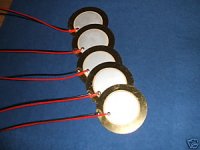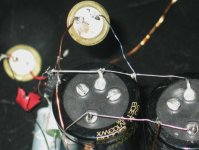piezobee
Piezo transducer guitar pick ups.
Bybee like???
absorb stray naughty sound damaging electrons ??
cheap and easy to buy from ebay for pennies.
Works when I add them after the voltage regulator on the positive line. The more of them i add the better the sound gets.
see photo attached,I removed the wire attached to the metallic side and re soldered it onto the opposite side onto the inner disc with the magical properties. I keep the two wires on this disc as far apart as possible so the signal has further to travel and can reap from its cleansing powers. I then wire it up onto the positive supply in series with it.
Used on the shigaclone with surprisingly good results.Only 8v mind. Not tried on other equipment as yet or higher voltages
No April Fool I promise you
Piezo transducer guitar pick ups.
Bybee like???
absorb stray naughty sound damaging electrons ??
cheap and easy to buy from ebay for pennies.
Works when I add them after the voltage regulator on the positive line. The more of them i add the better the sound gets.
see photo attached,I removed the wire attached to the metallic side and re soldered it onto the opposite side onto the inner disc with the magical properties. I keep the two wires on this disc as far apart as possible so the signal has further to travel and can reap from its cleansing powers. I then wire it up onto the positive supply in series with it.
Used on the shigaclone with surprisingly good results.Only 8v mind. Not tried on other equipment as yet or higher voltages
No April Fool I promise you
Attachments
I once made a 'guitar' with some scraps of wood,and some piezo discs as pickups. I soldered the (bailing wire)strings right to the discs.They worked great,and had a pretty 'hot' signal level,I could plug it into the back of a HT receiver,using the phono input and get some nice overdrive distortion.
Has anyone ever measured one of these,to see what kind of capacitance they have? I'd guess it's pretty low?
Has anyone ever measured one of these,to see what kind of capacitance they have? I'd guess it's pretty low?
Do you mean something like these.
http://cgi.ebay.com/10-pcs-35mm-Pie...hash=item270359739908&_trksid=p3286.m20.l1116
By the way, this was a break off of the shinga clone thread. So April fools it is not.
The specs from a different ebay listing were:
1. Plate material, stainless steel
2. Max input Voltage, 30 Volts peak-to-peak
3. Resonant impedance, 350 Ohms Max
4. Natural resonant frequency(Freely suspended), 4 KHz +/- 500 Hz
5. Capacitance at 1 KHz, 22 nanoFarads +/- 30%
6. Plate diameter, 20.0 mm
7. Plate thickness, 0.1 mm
8. Ceramic piezo diameter, 15 mm
9. Total thickness, 0.22 mm
22 nano farads. Yeah, I guess you could say they were low capacitance.
http://cgi.ebay.com/10-pcs-35mm-Pie...hash=item270359739908&_trksid=p3286.m20.l1116
By the way, this was a break off of the shinga clone thread. So April fools it is not.
The specs from a different ebay listing were:
1. Plate material, stainless steel
2. Max input Voltage, 30 Volts peak-to-peak
3. Resonant impedance, 350 Ohms Max
4. Natural resonant frequency(Freely suspended), 4 KHz +/- 500 Hz
5. Capacitance at 1 KHz, 22 nanoFarads +/- 30%
6. Plate diameter, 20.0 mm
7. Plate thickness, 0.1 mm
8. Ceramic piezo diameter, 15 mm
9. Total thickness, 0.22 mm
22 nano farads. Yeah, I guess you could say they were low capacitance.
yes DaveM thats the one
Placebo effect??? but then that's what this forum is for..... discovery . This is an extremely cheap one that anyone can try and see for themselves if it works or not.
In my system, switching back and forth I perceive that they add more natural tonal warmth and improve dynamics. Not night and day, but then are BYbees perceived to produce night and day results???
Please note I use high quality earphones with an OTL amplifier which are highly revealing and show up small changes very easily, but from personal experience this should be reproducible in a very high quality formal room system set up as well.
Placebo effect??? but then that's what this forum is for..... discovery . This is an extremely cheap one that anyone can try and see for themselves if it works or not.
In my system, switching back and forth I perceive that they add more natural tonal warmth and improve dynamics. Not night and day, but then are BYbees perceived to produce night and day results???
Please note I use high quality earphones with an OTL amplifier which are highly revealing and show up small changes very easily, but from personal experience this should be reproducible in a very high quality formal room system set up as well.
Check this stuff out.
http://www.omegapiezo.com/strip_actuators_bimorph_equivalent.html
If more is merrier with this stuff, here is the way to get it. This company also makes the bare piezo without termination. In other words, they make what is the bybee filters. If we had a bybee filter to disect and reverse engineer, we could have them custom made by these guys. Hmmmm. Group buy? Just my enthusiasm getting ahead of me.
It might be worth trying to get a sample of their large strips. I will see what I can do tomorrow.
http://www.omegapiezo.com/strip_actuators_bimorph_equivalent.html
If more is merrier with this stuff, here is the way to get it. This company also makes the bare piezo without termination. In other words, they make what is the bybee filters. If we had a bybee filter to disect and reverse engineer, we could have them custom made by these guys. Hmmmm. Group buy? Just my enthusiasm getting ahead of me.
It might be worth trying to get a sample of their large strips. I will see what I can do tomorrow.
I hear what you are saying and maybe we should simply talk about them as power supply filters. Jack Bybee has nothing to do with it. I would love to try a set of bybee filters. The only problem for me is the audiofool markup. At $175 a pair for the small ones and $480 for the large gold ones, I just can't see it. $15 for some piezo's I can manage. Hell maybe I will even learn something in playing with them.
On a similar topic, I have heard the Walker audio High definition Links. They are a dramatic improvement. But the cost at $395 is not worth it to me. My amp cost less than that to build.
The point here is DIY, not buy it from someone who has already done it. I would say the real courage is to try something new and maybe learn from it.
On a similar topic, I have heard the Walker audio High definition Links. They are a dramatic improvement. But the cost at $395 is not worth it to me. My amp cost less than that to build.
The point here is DIY, not buy it from someone who has already done it. I would say the real courage is to try something new and maybe learn from it.
ok i see that the title has been corrected.
O thats interesting, I see quotes of John Curl's name as having been involved in some of the design work for bybee products! Is that correct?
Any thoughts on my 'resonator' ?
i did research the concepts used to describe the Bybee filter mechanism on their web site, and did use that in a rather crude way to identify material that might mimic some of the physics describing its action. I fully appreciate that in no way have I bought an actual Bybee filter and analysed it to clone it and I have no idea if the bybee and my discovery have anything in common in terms of how they affect the sound.
HOWEVER, I have just acquired two ACTUAL ORIGINAL BY Bees a couple of the large ones and the smaller sized one so will be able to do a head to head with the bybee in my set up some time this week end. Now that should be interesting!
O thats interesting, I see quotes of John Curl's name as having been involved in some of the design work for bybee products! Is that correct?
Any thoughts on my 'resonator' ?
i did research the concepts used to describe the Bybee filter mechanism on their web site, and did use that in a rather crude way to identify material that might mimic some of the physics describing its action. I fully appreciate that in no way have I bought an actual Bybee filter and analysed it to clone it and I have no idea if the bybee and my discovery have anything in common in terms of how they affect the sound.
HOWEVER, I have just acquired two ACTUAL ORIGINAL BY Bees a couple of the large ones and the smaller sized one so will be able to do a head to head with the bybee in my set up some time this week end. Now that should be interesting!
Hi Tvicol
i am trying hard to remember the reasons behind my investigation of piezo's, but it was as a direct result of reading about purification theory in a roundabout way described by Bybee. It was quite a number of years ago that i came across the idea.
i have no electronic background whatsoever, but Just off the top of my head (and this might sound like rubbish to our more expert colleagues but please bear with me and think of similes) I wonder if the piezo is acting as an amplifier/mimicker of the input electron flow across it. But that some how the 'impure electrons' are not amplified-mimicked to the same extent which makes them less obvious in the output signal. The input voltage must be acting in a mechanical manner which is exciting the piezo atoms and triggering off an equivalent copy flow of the input which then somehow becomes purer????????????????
I need to try it for dac output signals as well to see if it will work here also.
Please remember it did not work at all on my DAC but superbly on the Shigaclone. With as described above a subjective increase in output level to the signal heard at the speakers.
i am trying hard to remember the reasons behind my investigation of piezo's, but it was as a direct result of reading about purification theory in a roundabout way described by Bybee. It was quite a number of years ago that i came across the idea.
i have no electronic background whatsoever, but Just off the top of my head (and this might sound like rubbish to our more expert colleagues but please bear with me and think of similes) I wonder if the piezo is acting as an amplifier/mimicker of the input electron flow across it. But that some how the 'impure electrons' are not amplified-mimicked to the same extent which makes them less obvious in the output signal. The input voltage must be acting in a mechanical manner which is exciting the piezo atoms and triggering off an equivalent copy flow of the input which then somehow becomes purer????????????????
I need to try it for dac output signals as well to see if it will work here also.
Please remember it did not work at all on my DAC but superbly on the Shigaclone. With as described above a subjective increase in output level to the signal heard at the speakers.
- Status
- This old topic is closed. If you want to reopen this topic, contact a moderator using the "Report Post" button.
- Home
- Amplifiers
- Power Supplies
- Piezobee -a very simple and cheap power filter

